Or, How I Made Money Out Of Alfa Romeo! Part One
By Chris Martin
I have never owned an Alfa Romeo, but twice I have personally done very well from their mistakes.
The first was in the mid-seventies when the Alfasud was their brave new hope. I was the guy who fixed the Suds!
As has been told here before, the Alfasud was a brilliant design badly made.
By the late 1960’s Alfa had identified that they needed to aim for the small car market with an all-new model and at the same time the Italian government was encouraging industry to invest in the southern half of Italy where unemployment was high.
Alfa Romeo at that time was part state owned and decided, or were persuaded, to build an all new factory on a site at Pomigliano d’Arco near Naples where it had previously made aero engines. Launched in 1972 the Alfasud – meaning of course Alfa South – was the first front-wheel-drive model from Alfa, with a mechanical layout designed by Rudolf Hruska (ex-Porsche) with input on detailing the body by Giorgetto Giugiaro at ItalDesign. Powered by a flat-four (another first for Alfa) the first right-hand-drive models went on sale in Britain in ’73, with the base model joined by the 1.2Ti although it was never officially offered on the other side of the Atlantic.
There were later variations on the theme, two and four door sedans, and a Giardinetta mini station wagon, along with various performance upgrades. A hatchback was introduced in 1981 by which time the Veloce Ti had an improved 95bhp 1490cc engine to at last deliver the performance the chassis was capable of handling. There was also the lower, wider Sprint version launched in 1976.
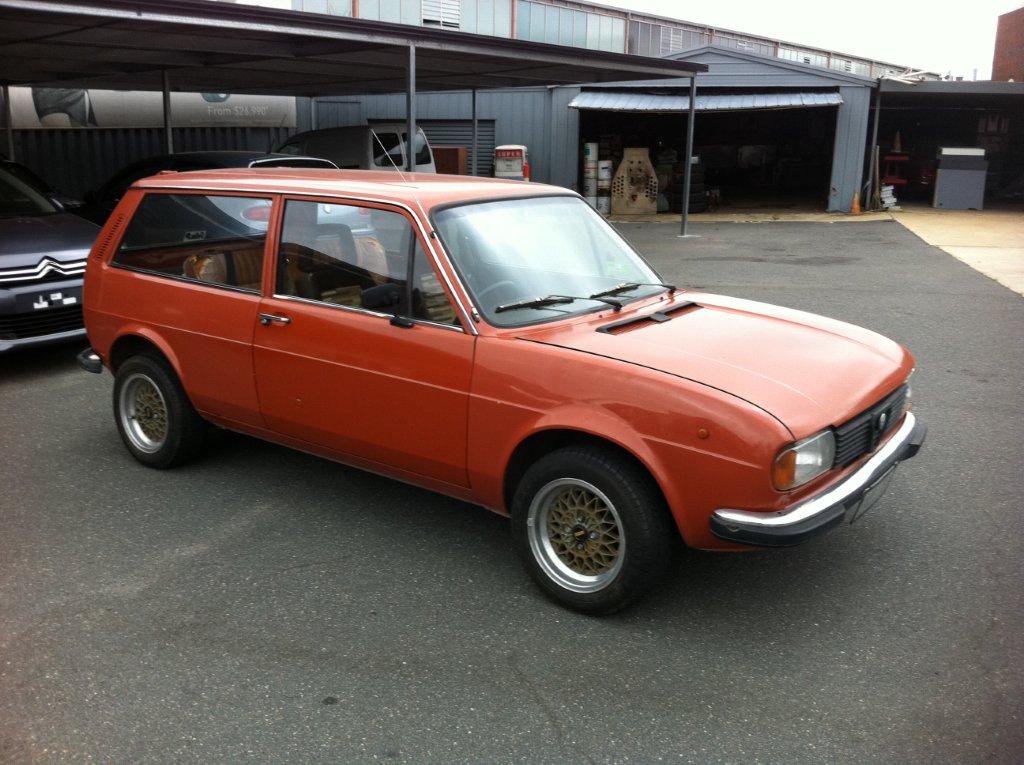
Reader Roy Gulson owned this rare Alfasud Factory Station wagon fitted with a 1.7 twin Weber engine, one of only 2 in Australia. Photo Roy Gulson.
Sales were initially good and press reviews favorable, but the problems soon surfaced, quite literally, as the rust started to show through the paint within months. Part of the problem was the inferior quality steel from the Soviet controlled Eastern Europe that the Italian government had agreed to import, and this was made worse by poor labor relations at the new factory. Frequent walk-outs and strikes meant that unfinished bodies were often stockpiled outside exposed to the salty air of the Mediterranean for a while before the workers returned to complete these cars. Painted and delivered, presumably without having had any anti-corrosion treatment, they were then shipped with rust already attacking the steel under the paint.
The Alfasud was also built at other manufacturing plants in Malaysia and South Africa supplying export markets; one wonders if these were made any better?
I had worked part time at MG racer John Britten’s garage at Arkley (in England) while still at school, and then after an apprenticeship at a Ford agent I was living in north London when the main Alfa dealer Hexagon of Highgate advertised for staff wanted at their body and paint repair shop in nearby Kentish Town in 1975. I was taken on and although they had some other high class cars pass through, including a couple of Aston Martin DBs and a Maserati 250F I was told belonged to Stirling Moss, I was mostly occupied with rebuilding rusty Alfasuds under warranty.
There was a non-stop queue of these coming in under warranty with extensive corrosion, some only sold a few months previously and there was a well organized production line in place to speed them through.
Every morning a windscreen fitter from an outside glass supplier came in and removed the front and rear screens which were marked with the relevant registration number and stacked in a corner where he then retrieved the screens to fit back into whichever cars had been repaired and were due to go back to their impatient owners that day.
I and a couple of others, including an Italian named Giovanni who drove a hot Mini Cooper (strangely not loyal to Alfa?) were then let loose on the wrecks to strip out whatever was needed to enable panels to be replaced prior to being painted. Under the warranty regulations all faulty parts were supposed to be replaced rather than repaired, and this certainly was done for front fenders, doors and other panels and minor parts that could be removed, but the rust had usually attacked the windscreen and rear window frames in the main bodyshell and this area was rubbed down to bare metal and filled where necessary; I never saw one rebuilt around a completely new shell.
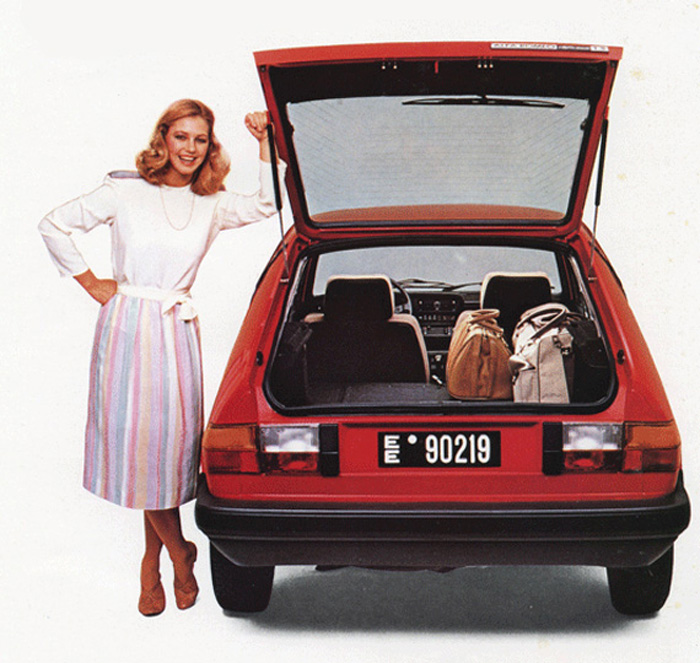
This car, from the brochure, has temporary Italian Export plates; the EE stands for Escursionisti Esteri meaning Foreign Travelers. These were issued for vehicles purchased in Italy for export or for those temporarily imported.
All trim that needed to be removed was labelled and stored and the door and window apertures masked off. If there was a need to repair and paint any areas of the engine compartment there was of course more dismantling to be done, but this was not often a problem area.
I do remember at least one front fender came off in my hands, it was already free from its moorings at the bottom and the flange where it bolted along the top side was so rotten I could bend it up and down a couple of times until it snapped right off. And no I am not Arnie Schwarzenegger!
Rolling shells were then pushed into a state of the art spray booth with heat lamps on both sides and an extraction system with constant running water under the grilles that ran the length of the floor. This worked so well that it was possible to work in there without face masks and there was very little overspray to be polished off the next day.
Luckily, many customers had opted for the typically Rosso Alfa red, with Bianco Capodimonte white the second most common, and cars were often queued by color to make it easier for the sprayers to keep going without having to clean equipment between cars.
After a day to let the fresh paint harden, the bodywork was then polished, cleaned and checked prior to reassembly. The demand was such that we could all work as much overtime as we wanted and as this was paid at the higher rate of time-and-a-half it was worth putting a couple of extra hours in the week and work a full day on Saturday.
All of this of course was charged to Alfa Romeo and although it must have cost them dear in the bank balance, the long term damage to their reputation must have been more punitive.
Despite the work done to repair the damage when the cars were first found to be faulty, most of them did not last long and will have succumbed to the poor build quality long ago such that the few Alfasuds that remain must by now have been properly restored and are presumably well looked after. The survivors will hopefully now be treasured as a rare and valuable classic.
A similar fate befell Lancia during this period, and while Hexagon were also agents for this once great brand too, they were already slow sellers so they made up only a small number of our patients in the bodyshop. In fact the early series Lancia Beta models rusted as badly as the Alfasud, and the ensuing press coverage must have contributed to their decision to finally withdraw from the British market, and all right-hand-drive countries, in 1994.
The Alfasud was eventually replaced in 1983 by the product of a joint venture between Alfa Romeo and Nissan, the truly awful Arna (named as an acronym for Alfa Romeo Nissan Autoveicoli) which was seen as mutually useful for Alfa to get a new model to market quickly, while providing Nissan with a foothold in the protectionist European countries. Of course the popular jokes about “what could be worse than a Japanese car built by Italians” kept the buyers away by the thousands. At least Alfa only had to take half the blame for that one, but it would be a few years more before they were able to regain a reputation worthy of their heritage.
My bank manager was probably a lot happier than the bean counters in Milan, but a year or so further on I had traded my smoky Ford Anglia for a clean, all original ’66 Mustang convertible and bored with so much red paint I had quit and gone into business with a friend in our own garage business. But that is another story for another time. As will be my second bite at the Alfa cake….
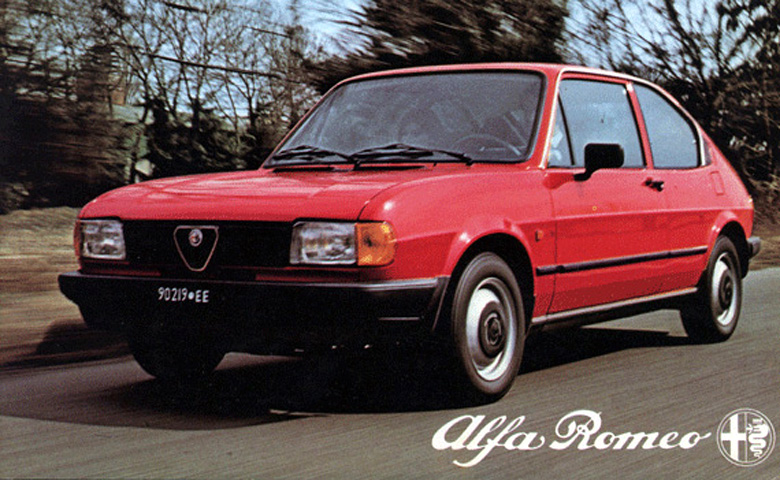

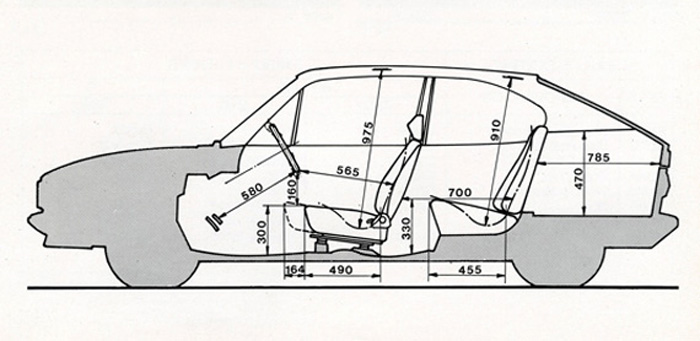
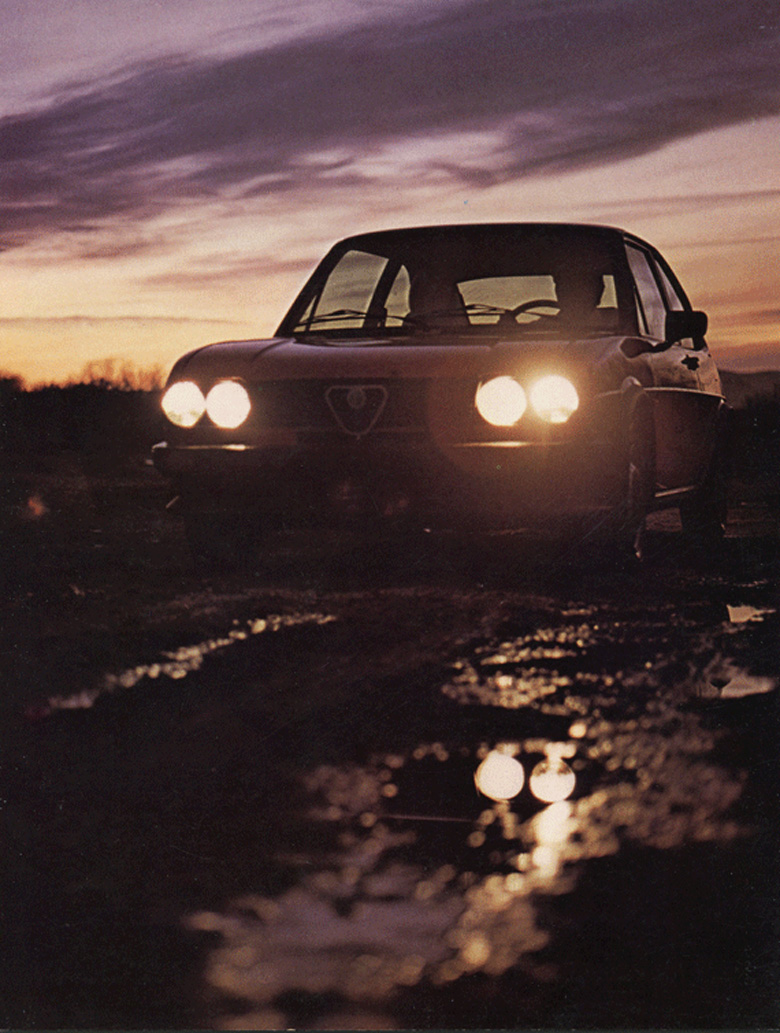
Chris Martin’s Alfa Spud (that’s what Doug Nye used to call them) story woke me up. It caused me to take down the Haynes Alfa Romeo Alfasud workshop manual from the shelf – the first time in 20 years, probably – that I had written in 1977. I don’t think it sold very well probably because everyone’s car was dealt with under warranty so no need to work on their own car!
At Haynes we would buy a used car, tear it down, rebuild it, and shoot photos and write it up as we went along. We never really looked at the bodywork but I don’t remember it being rusty, at least not like the Fiat 128 we had around at that time. Our project car was “my car” for about 9 months. My summer vacation was spent driving it to Athens, in Greece, and back. I don’t remember stopping for the night on the way down; I certainly didn’t on the way back. In the center of Athens I broke a headlamp on the sharp bit at the rear of a Triumph Herald Convertible occupied by four fat guys and so had to drive back with only one headlight after discovering that there were no Spud parts in town!
My fondest memory was driving the Yugoslavian coast road behind two open, dark blue, Swedish-registered Jaguar E-Types, a blond couple in each, and an orange German-registered BMW 2002. We drove nose to tail for over 100 miles non-stop. The Spud was well capable of staying with the train on that twisty road. Fabulous handling and brakes! The Spud had two stalks, one either “side” of the steering wheel. Pull them both for main beams and horns simultaneously to clear the road ahead.
I do remember visiting Hexagon of Highgate many, many times, double-dipping in the car showroom and then the motorcycle shop – I would test ride a Laverda out of that shop on several occasions.
Can’t wait for the next episode from Chris Martin.
My first Alfa was an AlfaSud Sprint Veloce and I still miss it to this day. It was an elegant beige yellow with a brown interior and the company’s legendary light green tainted windows. The impression it left me the first time I engaged that first gear turned me onto the Alfa virus. It hasn’t subsided much. It rocked my world when I was in my twenties.
I couldn’t believe how well that little car handled for a front wheel drive. Back then in the 80s, front wheel drive cars were loosy-goosy, but not the Alfa. It was solid, well-poised car with that little engine, ever so happy revving up.
I think I made up my mind to buy that first Sprint after putting it into third gear and cornering fast a street corner in Nice, France. I was sold.
They were actually pretty cool little cars.
Alfasud passed USDOT and EPA certification tests in late ’75 and I drove the test vehicle back from Detroit to Englewood Cliffs when I was working in technical service at Alfa Romeo inc.
Then I had use of the test car for a few weeks while the decision to put the car on market as a ’76 model was being tossed around and found it to be better handling than say the VW Rabbit (Alfasud had a negative roll radius built into its front suspension geometry).
However, paint started to fall off from use on the harsh NJ winter roads, interior plastic dashboard trim began to curl and rust was appearing in body seams. So basically due to crummy quality control at the factory, there was one US model which eventually wound up somewhere in America…most likely in a scrapyard.
I owned a TI (bought new from Ray Gulson) in Canberra, Australia, in the 1980s. Canberra being a long way inland rust was never a problem. It was a great little car. The only problem I had with it resulted from Ray’s mechanics swapping the front tyres when it went into service – the previously impeccable handling was shot and it took all of us a while to work out why. Took me and my family thousands of miles and I recall crossing the Hay Plains (flat, straight road running for miles) with two other adult males and running at 100 mph for some time on 1200 cc.
Spud real-world handling was superb. It was easily my favorite from all the cars Haynes had in the middle ’70s. I enjoyed the Fiat 128, Citroen GS, Renault 5 (Le Car to you), Renault 4, Citroen 2CV, all front-wheel drive of course, but the Spud was somehow better balanced and never to challenge the confidence of a hooligan.
I used to live about 130 miles from London, due west, connected by the A303 and the M3. My then girlfriend lived just north of Oxford Street in the fashion district of Central London…reaching her in time for supper on a Friday night after work demanded a manic driving discipline of maximum revs, tire squealing and no care for mileage – lust always exceeded economy – with every roundabout a three or even two wheel exercise. The Spud always had the winning time until the arrival of the first Honda Civic Hondamatic (I knew that would cause you to draw breath) which somehow required rudimentary left foot braking while hard on the throttle. Paddy Hopkirk had nothing on me! But that’s another story.
One Friday I was in trouble. I took off from the Haynes HQ in an AMC Gremlin that I was later than weekend to return to a (poor) US airman at the Lakenheath airbase. We had loaned a Toyota sedan for the Gremlin so that we could write a manual on it. That Gremlin is the only car that I have driven that has “gone bang” in my stewardship. And boy was it a bang! I recall little of the aftermath only that the airman wasn’t surprised!
Three weeks following I took the repaired Gremlin back and came away with a huge Chevy Impala. On my way home in it I went to the grocery store and placed my shopping bag on the floor behind the driver’s seat. The floor was so hot most of my food was inedible once I got home…a half pound of butter had melted through the bag, into the carpet and onto the metal floor pan. I never said anything to anyone.
AlfaSud was such a great little car, but why does everybody, without fail, batter the Arna? I had one among 12 or 14 Alfas at the time, including ‘Suds and Sud Sprints, Giulia Berlinas and Coupes (including a GTA), Giuliettas – both fifties and seventies iterations – Alfa 75s, 33s and more, and I loved it. It was as fast and as poised as a ‘Sud (still holds a lap record for Alfa racers at Knockhill), cheap to insure, neither pricy nor pretty, so eminently thrashable, and with no presence whatsoever, so barely a blip on the average rozzer’s radar. If you wanted to pose, it was beyond pointless, but if you want to experience the outer limits of the front wheel drive envelope, you really couldn’t touch an Arna. I recall mine with great fondness.
I rescued an early square headlight in Blu Procida (near enough Le Mans blue) 1200 L sedan in the mid 90s, partly because early ones were rare but mostly because I liked the colour. It was fitted with a single carb 1500 and 5 speed box and I used it for navigational rallying. I removed the rust, windscreens and doors mostly, painted it, patched up the unique and rubbish cardboard door trims, obtained new boot hinges and welded them on – always loved the way the boot flopped back on the rear window.
Filled it with about 12 cans of cavity wax, which didn’t contain the rust. Every time it got a stone chip the metal underneath was oxidised, so I figured it was rusting from the inside out.
The original 1500 engine was seriously tired after my navigator revved it around 8,000 rpm in a hill climb up Mt Panorama at Bathurst, it used to blow the oil filler cap off until I wired it on (a common problem) so I replaced it with a healthy twin carb. then it was fantastic. Handling was fantastic to 9 tenths, after that you had to remember that it was front wheel drive.
It was my hooligan car and I loved it, trouble was it was self biodegrading, no matter what I did, so I very regretfully sold it.
Seems several folks out there have memories of AlfaSuds.
Tim: Thanks for your past writing efforts, I often had to resort to Haynes manuals for various car fixes; I am sure you must have helped many people. If the ‘Sud you had in ’77 appeared to not be rusty, it may have been one we had already had through under warranty! And I too remember the interesting supply of American cars that came out of Lakenheath airbase (and Mildenhall and others) but your tale of blowing up a Gremlin beats anything I can claim – well done.
Nicolas: Yes, anyone who drove one was impressed, if only it was as well made it would have been a favourite even today.
Chris: Agreed, it was far superior to the VW Rabbit – or VW Golf to European readers – and that has long been held up as the benchmark for the first generation of post-Mini front-wheel-drivers. One other fault with the VW for right-hand-drive markets was the brake master cylinder stayed on the left so the brake pedal was connected by a complicated series of links and bellcranks. With a few miles on it, these soon developed some wear and the resulting lost motion between foot and fluid could result in a scarily long pedal. If only the ‘Sud body and trim had been built as well as the VW we would still be worshipping them today.
Liam: You say yours was not rusty, but then as you bought it in the ’80s one hopes Alfa had sorted the problem by then. I suspect it was the first couple of years production that were the worst, later models may have even had some sort of rust-proofing if they learned anything from the fiasco.
Will: My only experience of the Arna was servicing the brakes on one at another garage in the ’80s and I have to admit to not remembering much about driving it, and if I did, it would have been a test around the block, not pushing its handling to any limits. It was certainly no looker though, and from Alfa Romeo that fault alone is a major flaw.
John: Again, another who thought it a great performer but found it turned to dust despite lavishing care and attention.
And a couple of translations may be in order here. I am English, living in Australia, but I suspect a large part of the VT readership is in the USA, someone once said these were three countries divided by a common language.
Haynes manuals were the essential service and repair books, much like Chiltons were in the USA. A ‘rozzer’ is one of many British slang words for a cop. The ‘boot’ is the trunk in UK and Australia.
So, does anyone know of any surviving AlfaSuds?
My 1981 Alfasud sits in my Ottawa Garage awaiting spring. I have owned the car for over twenty years and have driven is well over 100,o00 Km in Canada, the UK and Italy. Its been a great car, with no serious rust problems. I had the engine rebuilt @ 150,000 Km, so its as good as new. When the snow melts, and the ice and salt are gone, she’ll be on the road again. I’ve never seen or heard of another one in Canada, and my ‘Sud always attracts folk with much fancier cars at Italian car events. I keep the Haynes manual in the trunk!
Thanks for the story
Dear Chris, dear Tim
Thank you for sharing your interesting memories with us.
I’ve been owning Alfasuds for over fourteen Years now and they still fascinate me as much as the first time i fired up one back in 1989.
These Cars with just a few tweaks can be made into something very rewarding.
I guess there are few Cars that provide so much 70’s thoroughbred Sportscar Feeling paired with uncompromised practicability.
It’s a shame these Cars are still so much underrated!
I would like to give a very special Thank to Tim Parker for writing the Haynes Manual about this Car.
I’ve gone through most of the chapters several times and it really is a default value.
No comparison to more recent works of the same Publisher!
I can only encourage all owners to keep running and caring their Suds and Sprints. The Sud really deserves its Laurels in the Classic Car Scene!
I should have spell checked before submission! So…….
I too have a strong Alfasud connection – I still own what is left of the 1977 1200Ti RYL243R that I bought as a spotty youth in August 1986 for 50 quid. Bought new from Hexagon on North Hill in May ’77 by a chap called Gary Leopold Marks (great name!) he only had it 18 months and one can guess why. By 1983 it had been through 5 owners, a colour change from Cilento brown (orangy brick red) to black with new wings and rear arches – just six years old. By the time I bought it, it had another three hotshoe owners and was in a state.
I did a day release apprenticeship at an Alfa dealer 1984/5 when the 33 had arrived, not a bad car but lacking a certain something. The Arna wasn’t that bad and drove quite well, but it was just so bland.
Aah – the Haynes manual! It had one flaw and that was the bit that said you could access the speedo end of the speedo cable from under the bonnet – no you bloody couldn’t! I wrote to Haynes but the manual is still printed to this day with this mistake. That apart it was a very good manual. I had another 13 or 14 Suds after that until around 1992/3. You could buy them for peanuts (20 – 300 quid), weld up the MOT failure rust and then hoon around in them. Sud Sprint Veloces were best with the twin carbs. Back from the pub at a late hour you could whip off the air cleaner lid in seconds and go rorting through town. I got to know all about keeping Suds going and mechanically they were very good. I became adept at replacing leaky brake calipers, replacing that sodding handbrake cable, adjusting valve clearances with the allen key and I could whip both heads off do a decoke in a day. Pity the first owners, but when they were cheap and plentiful, old Alfas really could not be beaten – not until old six cylinder BMW’s became plentiful cheap bangers in the mid 90’s.
great, I stay in Kenya I own a 1977 alfasud 5M have drive 250 000 km , have do none all sort of work from engine rebuild, to body work rust, have driven for the last 30 years,
It is possible to remove and replace the speedo cable under the bonnet withour removing anything,
Fiddly but definitely possible.
i have fond memories of being a passenger in my fathers 5yr old red alfasud sprint veloce with a black veloce stripe down the side it was a great car lovely sounding engine which popped on the overrun it was a quick car in its day seeing off xr3s from the lights and my head nailed to the headrest lol and handled as if it was on rails but after a accident one day after someone came out of side road i repaired the car in the garage i was working at i removed a wing and ended up rebuilding the inner wings as there no rust protection at all. A great car that was poorly built